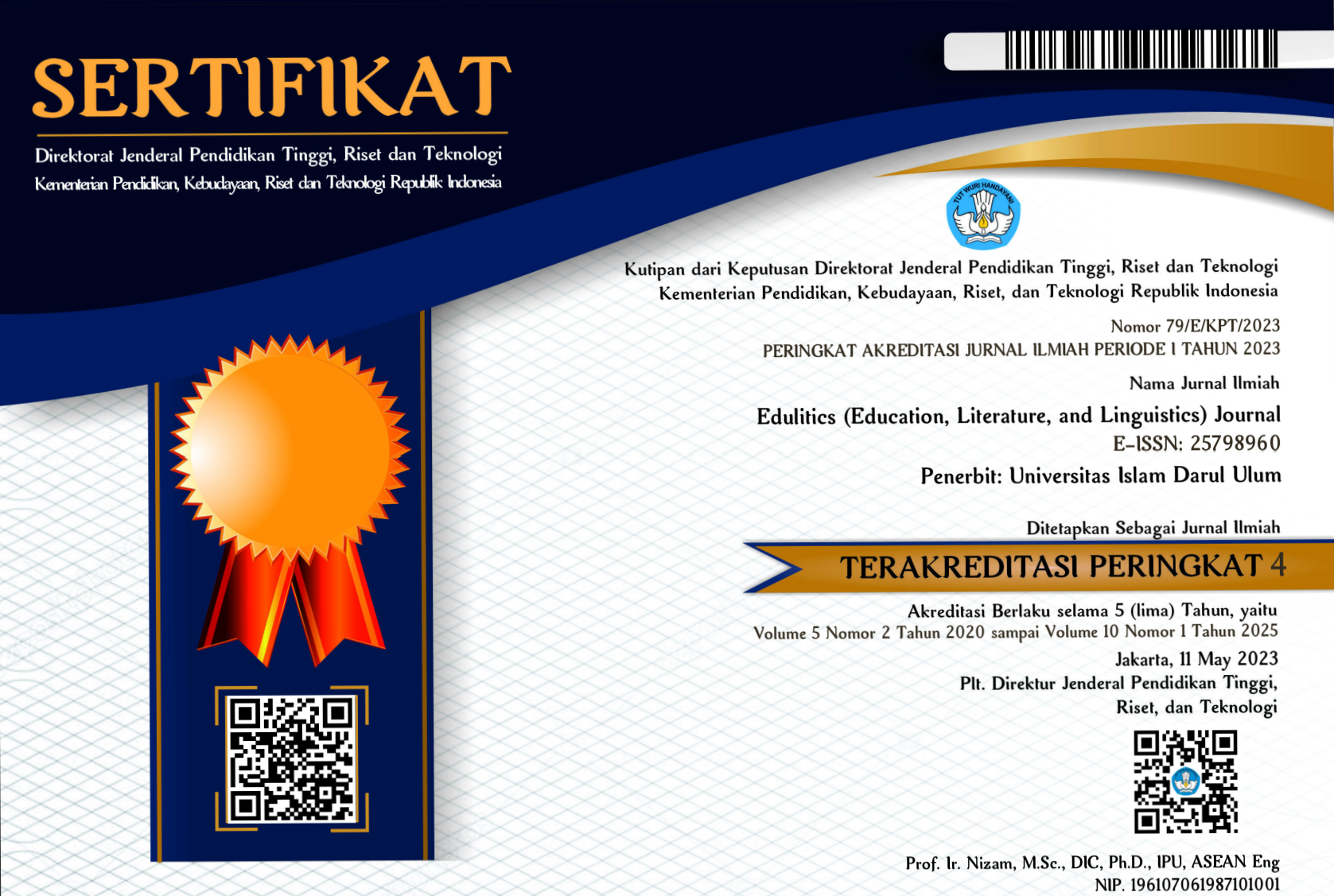The Impact of Intensifier as Women’s Persuasion Strategy in Politics Vice-Presidential Debate
Abstract
This study aims to analyze the impact of intensifier as a persuasive language strategy in politics used by Kamala Harris as a female politician in the 2020 vice-presidential debate. The study attaches to the qualitative research method focusing to construe in-depth analysis. Two primary sources are used in data gathering: vice-presidential debate transcription from rev.com and the vice-presidential debate video from NBCNews on YouTube. The methodological approach is the qualitative research method. The theoretical framework used as the main theory of this research is Quirk et. al‘s (1992) intensifier theory and Lakoff's (1975) women’s language features. The result found that there are 95 intensifiers. First, emphasizers (58%) with attitudinal and style disjuncts (46%) and 12%. Second, amplifiers (25%) with maximizers (18%) and boosters (7%). Lastly, downtoners (16%) with compromiser (1%), diminisher (1%), minimizer (7%), and approximator (6%). The most prevalent sort of intensifier used by Kamala and Hillary was the emphasizer attitudinal disjunct, e.g. "Clearly, Actually, Of course, Probably, Certainly, Really" The most prevalent convey varying levels of certainty and uncertainty about what is being conveyed. Additionally, it was discovered that the two female politicians were using these words as part of a persuasive strategy to convince the audience.
Downloads
References
Joseph, B.C., Hartanti, L.P., & Leliana, A. (2022). The Use of Women’s Language Features by Kamala Harris in the Vice-presidential Debate. Proceedings of the International Joint Conference on Arts and Humanities 2021 (IJCAH 2021).
Holmes, J. (2013). An Introduction to Sociolinguistics (4th ed.). USA: Routledge.
Krieg, G. & Diaz, D. (2016, October 10). Donald Trump vs. Hillary Clinton II: The nastiest lines. CNN Style. https://edition.cnn.com/2016/10/10/politics/presidential-debate-donald-trump-hillary-clinton-quotes/index.html
Lakoff, R. (1975). Language and Women's Place. New York: Harper & Row.
Lakoff., R. (2003). "Language, Gender, and Politics: Putting “Women” and “Power” in the Same Sentence," in The Handbook of Language and Gender, J. Holmes and M. Myerhoff, Ed. MA: Blackwell Publishing. pp. 161-178.
Lawless, J.L., Pearson, K. (2008). "The Primary Reason for Women’s Underrepresentation? Reevaluating the Conventional Wisdom," Journal of Politics, pp. 67-82. DOI: doi:10.1017/S002238160708005X
Page, S. (2020, October 8). Read the full transcript of vice presidential debate between Mike Pence and Kamala Harris. USA Today. https://www.usatoday.com/story/news/politics/elections/2020/10/08/vice-presidential-debate-full-transcript-mike-pence-and-kamala-harris/5920773002/
Quirk, R. G. (1992). A Grammar of Contemporary English. Longman Group Ltd.
Rudman, L.A., Goodwin, S.A. (2004). "Gender Differences in Automatic In-group Bias: Why Do Women Like Women More Than Men Like Men?" Journal of Personality and Social Psychology, pp. 494-509. DOI: doi:10.1037/0022- 3514.87.4.494
Rudman, L.A. (1998). "Self-promotion as a Risk Factor for Women," Journal of Personality and Social Psychology, pp. 629-645.
Sardabi, N. &. (2015). Gender differences in the use of intensifiers. Journal of Applied Linguistics and Language Research, 2(7), 203-213.
Setayesh, B. & D. (2018). A corpus-based contrastive analysis of the frequency of intensifiers in native and Iranian non-native English Speakers applied linguistics research articles (RAs). International Journal of Informatics, Technology & Computers, 1(1), 49–78.
Siregar, A. J., & Suastra, I. M. (2020). Women and Men Linguistic Features in the First Presidential Debate Hillary Clinton and Donald Trump in 2016. Udayana Journal of Social Sciences and Humanities (UJoSSH), 4(1), 1.
Tannen, D. (1996). Gender and Discourse. New York: Oxford University Press.
Wardani, Fidelia & Kristiani, Maria. (2020). Women’s Language Features in Michelle Obama’s Speech “The First Lady on the Importance of Studying Abroad.”. ELTR Journal. 1. 61-67. 10.37147/eltr.v1i2.44. https://doi.org/10.24843/UJOSSH.2020.V04.I01.P01

This work is licensed under a Creative Commons Attribution-ShareAlike 4.0 International License.
Authors retain copyright and grant the journal the right of first publication with the work simultaneously licensed under a Creative Commons Attribution-ShareAlike 4.0 International License that allows others to share the work with an acknowledgment of the work's authorship and initial publication in this journal.
Authors are able to enter into separate, additional contractual arrangements for the non-exclusive distribution of the journal's published version of the work (e.g., post it to an institutional repository or publish it in a book), with an acknowledgment of its initial publication in this journal.
Authors are permitted and encouraged to post their work online (e.g., in institutional repositories or on their website) before and during the submission process, as it can lead to productive exchanges and earlier and greater citation of published work.







_(1).png)


